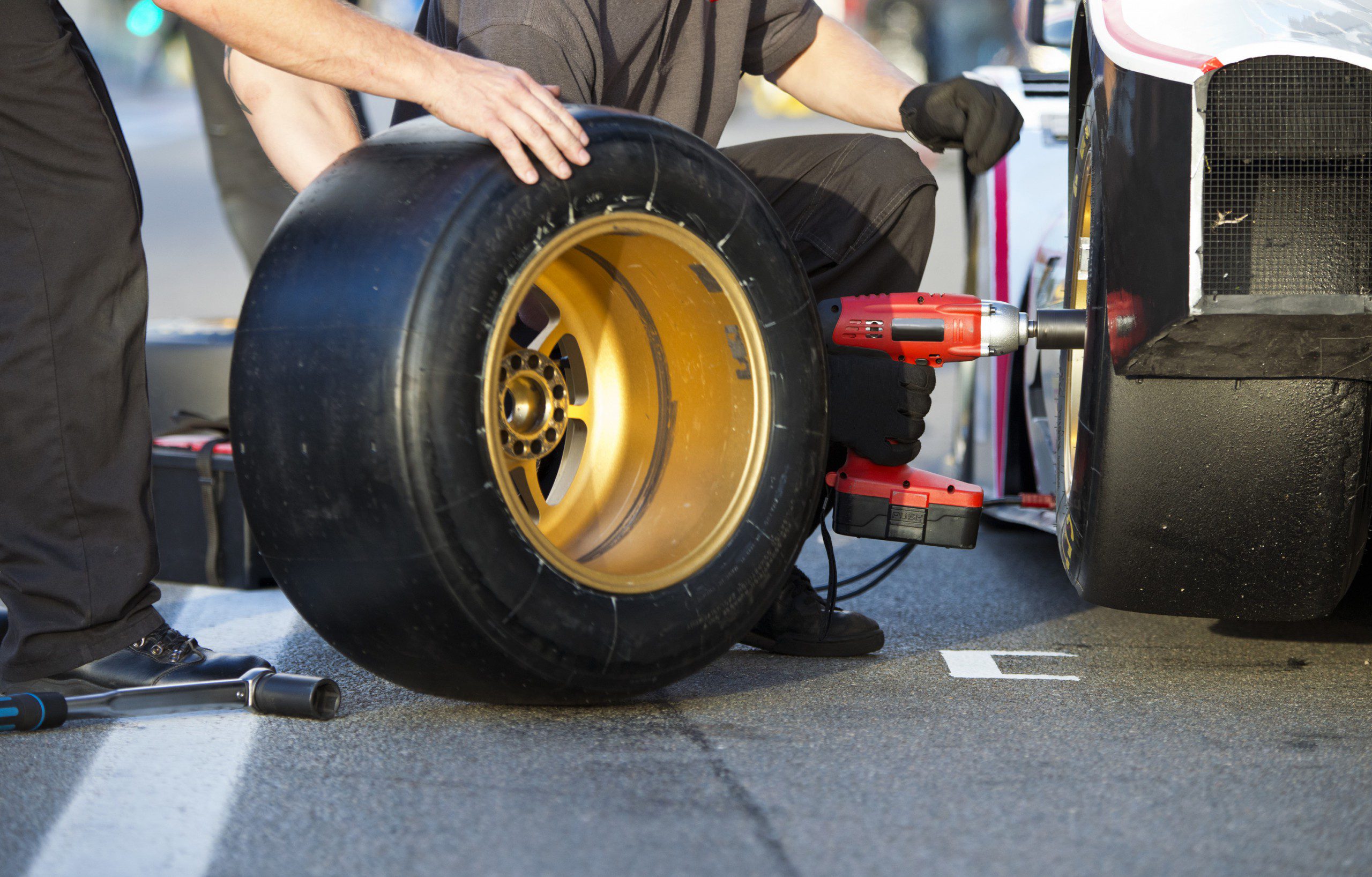By Tim Terry
Over the years, we have chatted in this space about many topics. Those include scratching the surface of many technical items of the various stock car racing divisions within the Atlantic Provinces. Among those subjects we have devoted space to in these pages in the past are tires, which is what this issue is rolling on – no pun intended!

As the old saying goes, “the more things change, the more things stay the same.” There have not been a ton of change to tires in the region, some divisions have seen slight changes on what rims can be run, but since the last time we tackled the subject a few years ago, tires haven’t seen a ton of change.
To refresh, tires and rims are two of the most pivotal things about a racecar, or a car in general as a matter of fact. The four black patches of rubber are the contact of the car to the road, or in our case, the track. When the car heads down a straightaway and falls into a banked left turn, while the suspension is doing a ton of work flexing and traveling as the car sinks into the bank, it is still the tire that has that connection to the surface. While you need to have the full setup package from bumper to bumper and a driver to get up on the steering wheel to ultimately land a team a trip to victory lane, the car rolls on tires to get it to that celebration when the checkered flag falls.
Most divisions in this region are on a spec tire. In short, those classes have a certain type of tire they must run. Some have tread depth rules and the rules on tire softener vary from sanction to sanction, but the tire itself comes from the same manufacturer. The Pro Stock/Pro Late Model division runs a Hoosier 1070 slick tire, while the Late Model Sportsman and Street Stock run a Hoosier 890 grooved tire. The Legend division runs on a Federal tire supplied by US Legend Cars International (USLCI) and their Bandolero counterparts run a tire also supplied by the USLCI shop in Harrisburg, North Carolina. The Passione Flooring & Interiors East Coast Mini Stock Tour and the Scotia Speedworld Thunder cars run on a used Legend car Federal tire, which is based off a street tire and can be bought with the same general specs from the manufacturer as a DOT tire. The Atlantic Modified Tour also runs with a used tire rule, utilizing used Hoosier slick tires that run on the Pro All Stars Series.
Tires can also be one of the biggest numbers when it comes to a racing budget throughout the year. Sure, a used tire is going to cost you less than a new tire and some teams can get away with running used tires over new tires. The Four Cylinder and Mini Stock teams that run on street tires have a floating budget. Several teams use tires from junk piles while others will buy brand new, top of the line tires that fit the rules for their respective track and get them cut, buffed or shaved to maximize their patch of rubber hitting the track when the green flies.
A number of tracks and series that run Street Stock, Sportsman and Pro Stock divisions have tire rules, where a team is only permitted to buy a certain amount of new tires per season or per the amount of races they have competed in. Even with those rules, the tires in those divisions cost in the ball park of $200 per tire, give or take a $20 bill or two in the balance. Top running full-time teams on the Parts for Trucks Tour have tire budgets of five figures in order to compete for the championship over their 12 race schedule. At the end of the day, it is a necessary evil and a tough balance to make in a budget. If you go without new tires when you are allowed to run them, you are, in essence, behind even before the green flies. Teams need to have an allowance of new tires at some point to prevent wearing the tire past the point of giving up. It is also car racing and you cannot race without tires on the car. It is an important balance to figure out for any short track team budgeting for a racing season.
Chemically altering the tire compound, or using “tire softener” as mentioned above, is still a hot button topic through racing circles. Some race tracks in the region allow their Sportsman and Street Stock teams to soak their tires, creating what some call within the region a chemical warfare. Other tracks have a number for a durometer (measuring the hardness of a tire) reading in their rulebook, which disqualifies a team if their tires are softer than that set number.
Some have a “dry tire” rule in their rulebooks, discouraging teams from using softener. The Parts for Trucks Pro Stock Tour and Speedway 660 take it a step further in their top class. The two sanctioning bodies impound the tires and rims used for racing in their Pro Stock/Pro Late Model divisions with the ultimate goal in mind of keeping the chemicals and the alteration of the four round patches of rubber on each race car has in contact with the pavement out of the equation. Additionally, it takes extra man power throughout the week and sometimes on race day on the track or series behalf to break down tires and mount tires. At the end of the day, it creates as level as a playing field as you can in the top division of pavement oval racing within Atlantic Canada and it has worked for both sanctions for the better part of, if not more than, two decades.
We could be here for pages debating tire softener, whether it is good or bad for the sport. Some say chemically treating a tire can make it last longer and therefore helping a driver’s budget in the long run. There is also the debate that the chemicals used in creating the perfect softener are harmful to your health and could have effects in the long run. It also brings the science into it; some drivers have their “recipe” for softener figured out and it works for them while others try to mix chemicals in an effort to concoct that perfect balance to make them go faster. Whatever way you slice it, the debate over tire softener is one that is talked about at the beginning of every year at competition meetings throughout the Atlantic Provinces and will likely be one until the final tire spins to a stop at pavement tracks in the region.
When it comes to rims, most divisions are running on a specially designed racing rim. Several manufacturers make racing rims and come in different sizes and specs based on the tire and what car they are going on. For the most part, the four cylinder classes around the region are the exception to the rule with those classes mandating that teams run the rims that are stock to the car. After all, those cars were once street cars and weren’t purposely built by Honda, General Motors or Dodge to be hustled around a closed circuit. Some sanctions do allow race rims on their four cylinder cars though.
Speedway 660 allows the Sharp Shooter division to run racing rims on the right hand side of their cars while the East Coast Mini Stock Tour allowed their cars to run racing rims with the used Federal Legend car tires beginning in 2019. Some teams saw the racing rims as a more solid choice with the strain on their stock rims which ultimately led to breaking those rims. For the East Coast Mini Stock Tour, it was also a choice of evolving the class into a racing tour to set themselves a part a bit from the norm of most Honda divisions in the region. The racing rims are not mandatory with the Series, which still allows a weekly competitor to run with them, but it gives the full time drivers an option if they so desire.
If we were to peer into the crystal ball, what would or could we see change with tires and rims in the near future across the region? I think the only ones with that clear vision are the decision makers within the sport – the tire and rim manufacturers, track and series promoters and their technical inspection personnel that govern the rules packages. Like anything, whether it be parts, tires, safety gear or ever changing technology, the industry is ultimately a business at the end of the day and those things cost money. Something as simple as international trade could have a trickle down effect on the short track racer if their parts come from outside North America. Not to mention the exchange rate between the US and Canadian Dollar having a direct effect on prices and what our local teams in this region pay for what they need to go racing. We’ve discussed this circle a bit here in the past, but it all essentially comes around and has an impact on this industry as a whole, which eventually makes its way to Atlantic Canada.
On the surface, not a lot has changed since we’ve talked about this topic within these pages. The proverbial apple cart may have hit a bump or two along the road but has continued to roll on without a ton of major changes, whether that be to rules, prices, compounds used, the softener debate or other aspects. Could we see a shift? Sure, anything is possible, but only time will tell. I guess we will have to look back here in a few years and see what has changed!
Until next time, keep the hammer down and we’ll see you at the track!

